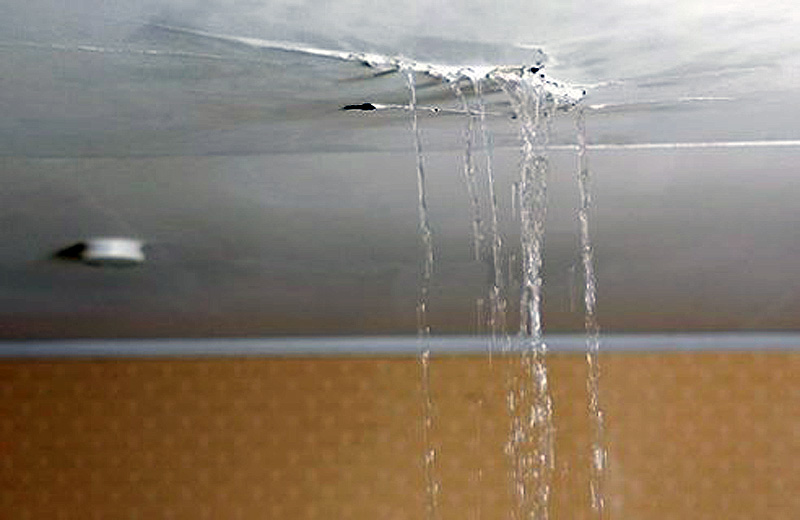What can cause a leak in the ceiling? Discovering a leak in your ceiling can be a distressing experience for any homeowner. A ceiling leak not only damages your property but can also be a sign of more significant issues within your home’s structure. In this article, we will explore the various factors that can lead to a ceiling leak, how to identify the source of the problem, and what steps to take when you encounter this issue.

Understanding Ceiling Leaks
The Telltale Signs
A ceiling leak is typically characterized by the presence of water stains, drips, or bulging areas on your ceiling. It’s essential to address ceiling leaks promptly, as they can lead to structural damage, mold growth, and compromised safety.
Common Causes of Ceiling Leaks
Identifying the Culprits
Several factors can contribute to a ceiling leak. Here are some of the most common causes:
1. Roof Leaks
Roof leaks are a prevalent source of ceiling leaks. Damage to the roofing material, such as missing shingles, cracked flashing, or deteriorated sealant, can allow water to penetrate the roof and make its way into your home.
Leaking or burst pipes can release a significant amount of water into your ceiling. This can occur in both supply pipes that carry freshwater and drain pipes that remove wastewater.
3. Condensation
In certain climates, high humidity levels can lead to condensation forming on the ceiling, particularly in areas with inadequate ventilation. Over time, this moisture buildup can result in a ceiling leak.
4. HVAC System Problems
Air conditioning units and heating systems produce condensation, which must be properly channeled away from your home. If the condensate drainage system malfunctions, it can lead to water damage and ceiling leaks.
5. Clogged Gutters and Downspouts
A buildup of leaves, debris, or ice in your gutters and downspouts can prevent water from properly draining away from your home. This can result in water overflowing and seeping into your ceiling.
6. Flashing Issues
Flashing is used to create a watertight seal around roof penetrations such as chimneys, skylights, or vents. If the flashing is damaged or improperly installed, it can allow water to infiltrate your home.
Identifying the Source of the Leak
Detective Work
When you encounter a ceiling leak, identifying the source is crucial. Here are steps to help you pinpoint the issue:
1. Inspect the Attic
Begin by checking your attic for signs of leaks. Look for wet insulation, water stains, or any visible damage to the roof structure.
2. Trace the Water Path
Trace the path of the water from the ceiling leak to its source. This will help you narrow down the potential causes.
3. Check the Roof
Inspect your roof for damaged or missing shingles, flashing problems, and any visible holes or gaps.
4. Examine Plumbing
Check the plumbing in the vicinity of the leak for any signs of leaks, corrosion, or damage.
5. HVAC and Condensation
Examine your HVAC system and the area around it for condensation, clogs, or malfunctioning drainage.
6. Gutters and Downspouts
Clear any debris from your gutters and downspouts and ensure they are directing water away from your home.
Taking Action on Ceiling Leaks
Addressing the Issue
Once you’ve identified the source of the ceiling leak, it’s time to take appropriate action:
1. Roof Repairs
If the source is a roof issue, contact a roofing professional to assess and repair the damage. Prompt repairs can prevent further water infiltration.
2. Plumbing Repairs
For plumbing-related leaks, a licensed plumber can fix the issue, whether it’s a leaking pipe, damaged connection, or a burst pipe.
3. HVAC Maintenance
Schedule routine HVAC maintenance to prevent condensation-related issues and ensure proper drainage of condensate.
4. Gutter and Downspout Maintenance
Regularly clean and maintain your gutters and downspouts to prevent water overflow and subsequent leaks.
5. Ceiling Repairs
After addressing the source of the leak, you may need to repair the damaged ceiling. This can include replacing drywall, repainting, and addressing any cosmetic or structural damage.
Conclusion
Ceiling leaks can be a homeowner’s nightmare, but identifying the source of the problem and taking prompt action are crucial steps to prevent further damage. By understanding the common causes of ceiling leaks and conducting a thorough inspection, you can effectively address the issue and protect your home from structural damage and related problems like mold growth.